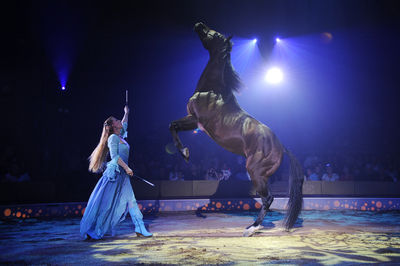Technology has seeped into every possible area of our society. The world of equestrian has had it no different. There have been numerous advantages to adopting Tech. First, the internet has enabled experts in the equestrian field to share best practices with one another in real-time. Second, sophisticated medical devices have made it possible to maintain systematic records on the health parameters of horses, to ensure owners are aware of the animal’s well-being. Third, ultra-modern sensors keep track of animal movements in the stable, so if there is any distress detected, its carers can reach it immediately to address the issue. And finally, it helps in tracing the essential relationship the horse shares with its rider, thereby providing a chance for trainers to strengthen the bond they have.

In this piece, we track the futuristic gadgets flooding the equestrian markets.
- Blockchain: This is a system in which a record of transactional information is maintained across computers that are linked in a peer-to-peer network. Though its uses have been found most beneficial to organisations in the financial space, it is steadily gaining a foothold in other areas as well. Blockchain allows horse owners from across the world to store valuable information about horses, and their prices, among others in electronic devices. Essentially, an equine enthusiast can access the database to gather any needed information. These days several federations require microchips to be inserted in horses, including the United States Equestrian Federation, to monitor the animal’s health status. Consequently, Microchip manufacturers are benefiting from the move, but so will prospective horse owners, veterinarians and anyone else interested in learning more information about a specific animal.
- 3D Printing: 3D printing, also known as additive manufacturing, is the construction of a three-dimensional object from a digital 3D model. It can be done in a variety of processes in which material is deposited, joined or solidified under computer control, with the material being added together, typically layer by layer. Commonwealth Scientific and Industrial Research Organisation in Australia has recently developed a 3D horseshoe printing technology to generate horseshoes using imaging software that analyses the hoof in detail to provide shoes with a superior ergonomic fit. In a similar vein, it could also be used to design prosthetics for animals with injured legs.

- Virtual Reality: Virtual reality is a simulated experience that employs pose tracking and 3D near-eye displays to give the user an immersive feel of a virtual world. It provides a revolutionary way for veterinarians to practise surgeries on horses. Complex surgeries can now be practised in a classroom ad libitum, minimising the risk to animals. It also helps in saving the animal from enduring invasive procedures, while simultaneously providing a rich simulated learning experience.
- Movement Sensors: A sensor is a device that detects events and changes in its environment and sends the information to other electronics, consequently sensors generally come paired with other electronics. Advanced wearable horse girth allows for the measurement of a horse’s heart and breathing rate during various types of movements like walking, trotting, cantering, and galloping. This collected information is saved for review. The inferences drawn from that review could later be used for fine-tuning the training program based on the evaluation of the horse’s performance.

- Internet of Things: The Internet of Things describes physical objects with sensors, processing ability, software and other technologies that connect and exchange data with other devices and systems over the Internet or other communications networks. One of the more recent arrivals in this segment has been connected saddles. These record data such as the regularity of a horse’s strides, and speed, among others. Post that, all the collected data is transmitted via Bluetooth to smartphones for instant feedback, thereby aiding in improving horse performance and efficiency.
- Artificial Intelligence: Artificial intelligence is intelligence—perceiving, synthesising, and inferring information—demonstrated by machines, as opposed to intelligence displayed by humans. An example, in this case, includes speech recognition, computer vision, and translation between languages, among others. AI-powered wearable devices collect data about external field conditions like temperature, humidity, etc, that will after that be thoroughly analysed in order to provide recommendations to trainers.

- Drones: Drones are flying robots that can be remotely controlled by an on-ground handler. Though their specific uses in the field of equestrianism remain unclear, it is believed that they could potentially be deployed to deliver vaccines to veterinarians in remote areas, who treat horses.
- Augmented Reality: Augmented reality is an interactive experience that combines the real world and computer-generated content. The content can span multiple sensory modalities, including visual, auditory, and olfactory. Equine thermography, for instance, uses a camera that detects infrared waves on the horse’s body surface that are invisible to the human eye. Specific devices use that information to detect issues in horses’ ligaments, tendons, and muscles, among others to detect prospective injuries often weeks before the animal is even showing signs of pain, allowing for the opportunity to preventatively treat the animal.




